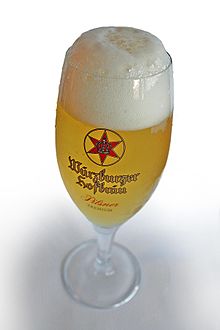
Back رغوة الجعة Arabic Espluma de cerveza AST Escuma de la cervesa Catalan Pivní pěna Czech Bierschaum German Espuma de cerveza Spanish Garagardo apar Basque Bira köpüğü Turkish


Beer head (also head or collar)[1] is the frothy foam on top of beer and carbonated beverages which is produced by bubbles of gas, predominantly carbon dioxide, rising to the surface. The elements that produce the head are wort protein, yeast and hop residue. The carbon dioxide that forms the bubbles in the head is produced during fermentation as yeasts break down sugar-rich molecules to produce ethanol and carbon dioxide. The carbonation can occur before or after bottling the beer. If the beer continues fermenting in the bottle, then it naturally carbonates and the head is formed upon opening and pouring the beer. If the beer is pasteurized or filtered then the beer must be force carbonated using pressurized gas.
The density and longevity of the head will be determined by the type of malt and adjunct from which the beer was fermented. Different mash schedules and cereal sources influence head retention. In general, wheat tends to produce larger and longer-lasting heads than barley.
Closely related to the beer head is "lacing" or "lace", a white foamy residue left on the inside of the glass as the head recedes or as the beer is drunk. Just as the composition of the beer (proteins, hops, yeast residue, filtration) affects a beer's head, the amount of lacing is also closely controlled by the specific composition of the beer, and beer connoisseurs can tell much by the lacing, though strictly speaking beer quality is not readily apparent by the head or the lacing.[2]
- ^ Gregg Smith and Carrie Getty, Beer comes from the gap in the bottom of the glass. The Beer Drinker's Bible (Boulder CO, 1997).
- ^ "What is beer lacing". vinepair.com. 7 December 2016. Archived from the original on 20 February 2018. Retrieved 19 February 2018.